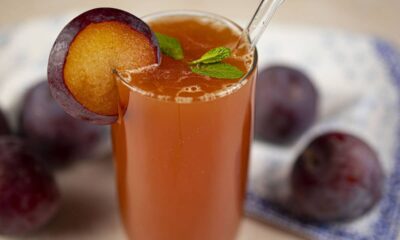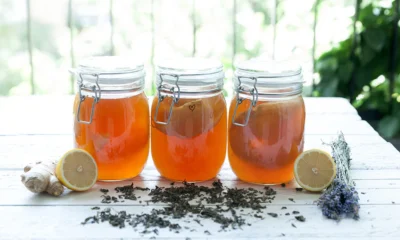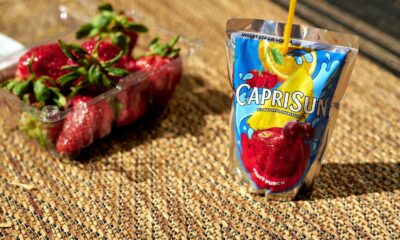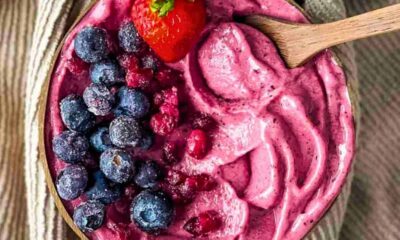DRINKS
Want To Brew Your Own Beer? Here’s How!
Published
2 months agoon

Brewing beer at home is a rewarding and enjoyable process. With the right ingredients and equipment, you can make your own unique craft beer. This guide will show you how to brew beer from start to finish.
Whether you’re a beginner or looking to refine your skills, this article will walk you through every stage of the brewing process.
Ingredients You’ll Need
To start brewing, gather these essential ingredients:
- Malt (Barley or other grains)
- Water
- Hops
- Yeast
- Priming Sugar
Each ingredient plays a key role in the beer-making process. Malt provides the sugars needed for fermentation, hops add bitterness and flavor, yeast ferments the sugars, and water makes up the majority of the beer’s volume.
Equipment for Brewing Beer
Before learning how to brew beer, ensure you have the following equipment:
- Brew kettle (a large pot for boiling)
- Fermenter (a sealed container for fermentation)
- Airlock (to let gas escape during fermentation)
- Siphon tubing (for transferring beer)
- Bottles and bottle caps
- Thermometer (to measure temperature)
- Sanitizer (for cleaning equipment)
Proper sanitation is crucial when brewing beer. Always clean and sanitize your equipment to avoid bacteria that could spoil your batch.
How to Brew Beer
Step 1: Heat the water and malt
To begin the process of how to brew beer, fill your brew kettle with water. Heat the water to around 160°F (71°C), then add your malt extract or crushed grains. Stir the mixture thoroughly to prevent clumping.
Mash Process
In this step, you’re creating the “mash.” The heat allows the enzymes in the malt to convert the starches into fermentable sugars. Keep the temperature steady for about 60 minutes. This process extracts the necessary sugars to feed the yeast during fermentation.
Step 2: Boil and add hops
After the mash is complete, increase the heat and bring the mixture to a boil. This boiling process is essential when learning how to brew beer because it sterilizes the wort (unfermented beer). Once the mixture reaches a rolling boil, it’s time to add the hops.
Why add hops?
Hops add bitterness, flavor, and aroma to your beer. The longer the hops boil, the more bitterness they impart. Add hops at various stages during the boil to achieve the desired flavor. Typically, the boil lasts about 60 to 90 minutes.
Step 3: Cool the wort
After boiling, the next critical step in how to brew beer is cooling the wort as quickly as possible. Rapid cooling prevents bacterial contamination and helps improve clarity. Use an ice bath or a wort chiller to bring the temperature down to around 70°F (21°C).
Why is cooling important?
Cooling the wort quickly is vital because yeast thrives at lower temperatures. If the wort is too hot, the yeast will die or produce unwanted flavors. A wort chiller can cool the liquid faster than an ice bath, making it a helpful tool in brewing.
Step 4: Transfer to the fermenter
Once the wort is cool, carefully transfer it to the fermenter using a siphon. Avoid splashing, as too much oxygen at this stage can affect the beer’s flavor. Secure the fermenter with an airlock.
The next step in how to brew beer is adding the yeast (pitching). Sprinkle the yeast over the cooled wort and close the fermenter. The yeast will begin to ferment the sugars, producing alcohol and carbon dioxide.
Step 5: Ferment the beer
Fermentation is a crucial part of how to brew beer. Store the fermenter in a dark, cool place, ideally around 65-75°F (18-24°C). Depending on the yeast strain and beer style, fermentation will take about one to two weeks.
What happens during fermentation?
During fermentation, yeast consumes the sugars in the wort, producing alcohol and carbon dioxide. The airlock allows gas to escape while keeping contaminants out. Monitor the fermentation process by watching for bubbles in the airlock. When bubbling slows, fermentation is nearing completion.
Step 6: Bottle the beer
After fermentation, it’s time to bottle your beer. First, you’ll need to mix priming sugar with the beer. This step is crucial because it triggers a small secondary fermentation in the bottles, creating carbonation.
How to bottle beer
- Clean and sanitize your bottles and caps.
- Dissolve priming sugar in water and add it to the beer.
- Use a siphon to transfer the beer into bottles, leaving about an inch of space at the top.
- Cap the bottles tightly.
Let the bottles sit at room temperature for one to two weeks. This waiting period allows the beer to carbonate.
Step 7: Store and enjoy your beer
Once the beer is carbonated, store the bottles in a cool, dark place. When you’re ready to enjoy your brew, chill a bottle, open it carefully, and pour it into a glass. Be sure to leave any sediment at the bottom of the bottle behind.

Frequently Asked Questions (FAQs) on How to Brew Beer
1. How long does it take to brew beer?
The entire process of how to brew beer, from boiling to bottling, takes about four to six weeks. The brewing process itself takes a few hours, but fermentation and carbonation require time. Fermentation can last one to two weeks, while carbonation in the bottles usually takes another one to two weeks.
2. What is the best temperature for fermentation?
The ideal fermentation temperature for most ales is between 65-75°F (18-24°C). If the temperature is too high, the yeast may produce unwanted flavors. Keeping the fermenter in a cool, stable environment helps ensure a clean fermentation.
3. Can I brew beer without hops?
Yes, it’s possible to brew beer without hops, but hops provide bitterness and balance to the beer’s sweetness. Without hops, your beer may taste overly sweet and lack the flavor complexity hops provide. Historically, people used herbs like gruit instead of hops for bitterness.
4. What type of yeast should I use for brewing beer?
The type of yeast you choose depends on the style of beer you want to brew. For ales, ale yeast works best, while lagers require lager yeast. Ale yeast ferments at higher temperatures and produces fruity, complex flavors. Lager yeast ferments at cooler temperatures, resulting in a cleaner, crisper taste.
5. Can I brew beer with fruits or spices?
Yes, many homebrewers add fruits or spices to their beer for unique flavors. These ingredients can be added during fermentation or the brewing process. Common additions include citrus zest, berries, cinnamon, and vanilla. However, it’s important to balance these flavors with the beer’s base ingredients.
6. How can I improve my beer’s clarity?
To improve beer clarity, ensure you cool the wort quickly after boiling. Adding a clarifying agent like Irish moss or gelatin can also help. Finally, allow enough time for fermentation and carbonation, as beer often clears up after extended time in the bottle.
7. What if my beer doesn’t carbonate?
If your beer doesn’t carbonate, it may be due to insufficient priming sugar or improper sealing of the bottles. Ensure that you add the right amount of priming sugar and that your bottles are tightly capped. In some cases, giving the beer more time to carbonate can resolve the issue.
8. How do I avoid contamination when brewing beer?
Sanitation is key to avoiding contamination. Always clean and sanitize your equipment before and after use. Contaminants like bacteria and wild yeast can spoil your beer if they enter the brewing process. Using an airlock during fermentation also prevents contamination.
9. Can I brew beer without a kit?
Yes, you can brew beer without a kit by gathering the necessary ingredients and equipment separately. Brewing from scratch gives you more control over the beer’s flavor and ingredients.
However, kits can be a great option for beginners who want a simple way to start brewing.
10. How to brew beer at home for beginners?
Beginners can start by using a beer brewing kit, which includes pre-measured ingredients and instructions. Following this step-by-step guide on how to brew beer is another great way to learn.
Begin with basic equipment and ingredients, practice sanitizing, and follow each step carefully for a successful batch.
Conclusively, learning how to brew beer at home is both fun and satisfying. By following the steps outlined in this guide, you can create your own craft beer in just a few weeks.
Whether you’re experimenting with different ingredients or perfecting your technique, brewing beer is a creative process with endless possibilities. With patience and practice, you’ll master how to brew beer and enjoy the fruits of your labor with friends and family.
If you enjoyed this article and would like to read more on drinks, visit this page.
DRINKS
5 Health Benefits Of Drinking Warm Water Early In The Morning
Published
7 days agoon
November 16, 2024
Drinking warm water early in the morning has gained popularity for its numerous health benefits. This simple habit can transform your wellness routine, boost your overall health, and promote a positive start to your day.
If you’re looking for a natural and effective way to improve your body and mind, consider starting your day with a glass of warm water.
This article will explore five key benefits of this daily practice.
1. Enhances Digestion
One of the primary benefits of drinking warm water in the morning is its positive effect on digestion. The warmth helps to stimulate your digestive tract, making it easier for food to pass through smoothly.
- Aids in breaking down food: Warm water helps dissolve and break down food particles more efficiently, easing the workload of your digestive organs, especially the stomach.
- Relieves constipation: Drinking warm water on an empty stomach can soften hardened stools and stimulate bowel movements, helping relieve constipation.
- Flushes out toxins: By increasing blood circulation, warm water can assist in removing waste and toxins from your system. This cleansing process can prevent bloating and discomfort.
Starting your day with warm water ensures your digestive system is ready to take on meals throughout the day.
2. Promotes Weight Loss
If you’re looking to lose weight naturally, drinking warm water in the morning could be a simple and effective method. This habit can boost your metabolism, which is essential for burning calories.
- Increases metabolic rate: Warm water raises your body temperature slightly, which prompts your metabolism to speed up. This means you’ll burn calories more efficiently throughout the day.
- Reduces appetite: Drinking a glass of warm water before eating can help curb your appetite. It creates a feeling of fullness, which may prevent overeating.
- Breaks down fat deposits: Warm water helps break down fat deposits in your body, making it easier to shed unwanted weight. It also assists the kidneys in functioning more effectively, which can help reduce water retention.
Combining warm water with a healthy diet and exercise can accelerate your weight loss journey.
3. Improves Blood Circulation
Good blood circulation is vital for delivering oxygen and nutrients to every part of your body. Drinking warm water helps enhance blood flow, which supports overall health and vitality.
- Relaxes blood vessels: The heat from warm water can dilate your blood vessels, making it easier for blood to circulate freely. This reduces the strain on your heart and can lower blood pressure.
- Prevents blood clotting: Warm water can help reduce the risk of blood clots by keeping your blood in a thinner, more fluid state. This can be especially beneficial for people with circulation problems.
- Supports muscle and joint health: Improved blood circulation can help relax tight muscles and relieve joint pain, making it ideal for those with arthritis or muscle soreness.
This increased blood flow can also help your skin glow, giving you a healthier, more youthful appearance.
4. Supports Detoxification
Your body accumulates toxins from food, the environment, and stress. Drinking warm water in the morning can help flush these toxins out, promoting better organ function and overall health.
- Boosts kidney function: Warm water supports your kidneys’ filtering process, making it easier for them to remove waste. Proper hydration can prevent kidney stones and urinary tract infections.
- Stimulates sweating: The heat from warm water can raise your core body temperature slightly, encouraging sweating. Sweating is a natural way for your body to expel toxins through your skin.
- Improves liver function: A glass of warm water can stimulate the liver to produce bile, which aids in digesting fats and eliminating toxins. This keeps your liver functioning optimally.
Regular detoxification helps you feel more energetic, reduces fatigue, and can even improve your mental clarity.
5. Relieves Nasal Congestion and Sore Throat
If you suffer from allergies, colds, or respiratory issues, warm water can be a soothing remedy. It helps clear your nasal passages and provides relief from sore throats.
- Loosens mucus: Warm water helps dissolve mucus, making it easier to expel through coughing or sneezing. This can provide relief from nasal congestion, especially during flu season.
- Soothes irritated throat: Warm water can soothe an irritated or scratchy throat, often caused by dryness or infection. It can also help prevent throat irritation, especially for people who wake up with a dry throat.
- Reduces inflammation: The warmth can calm inflamed tissues, reducing swelling and discomfort in the respiratory tract. This is especially beneficial for people with asthma or chronic bronchitis.
By starting your day with warm water, you can breathe more easily and reduce the discomfort associated with seasonal allergies or colds.
How to Maximize the Benefits of Drinking Warm Water in the Morning
Now that you understand the benefits, here’s how you can make the most of this simple practice:
1. Drink it on an empty stomach: To achieve optimal results, drink warm water first thing in the morning before consuming any food or drinks.
2. Add lemon or honey: For an extra health boost, add a slice of lemon or a teaspoon of honey. Lemon provides vitamin C and antioxidants, while honey has antibacterial properties.
3. Avoid boiling water: The water should be warm, not boiling, to avoid burning your mouth or oesophagus. Aim for a comfortable, soothing temperature.
4. Be consistent: Consistency is key to reaping long-term benefits. Make it a habit to drink warm water every morning for a few weeks to see noticeable improvements.
Drinking warm water in the morning is a simple, effective, and natural way to enhance your health. It promotes digestion, aids in weight loss, improves circulation, supports detoxification, and relieves nasal congestion.
By adopting this practice, you can kickstart your day on a healthy note and enjoy better physical and mental well-being. Why not give it a try tomorrow morning? Your body will thank you!
Visit here for more healthy tips.
DRINKS
Ever Tasted Sweet Plum Juice? Here’s How To Brew One!
Published
2 weeks agoon
November 10, 2024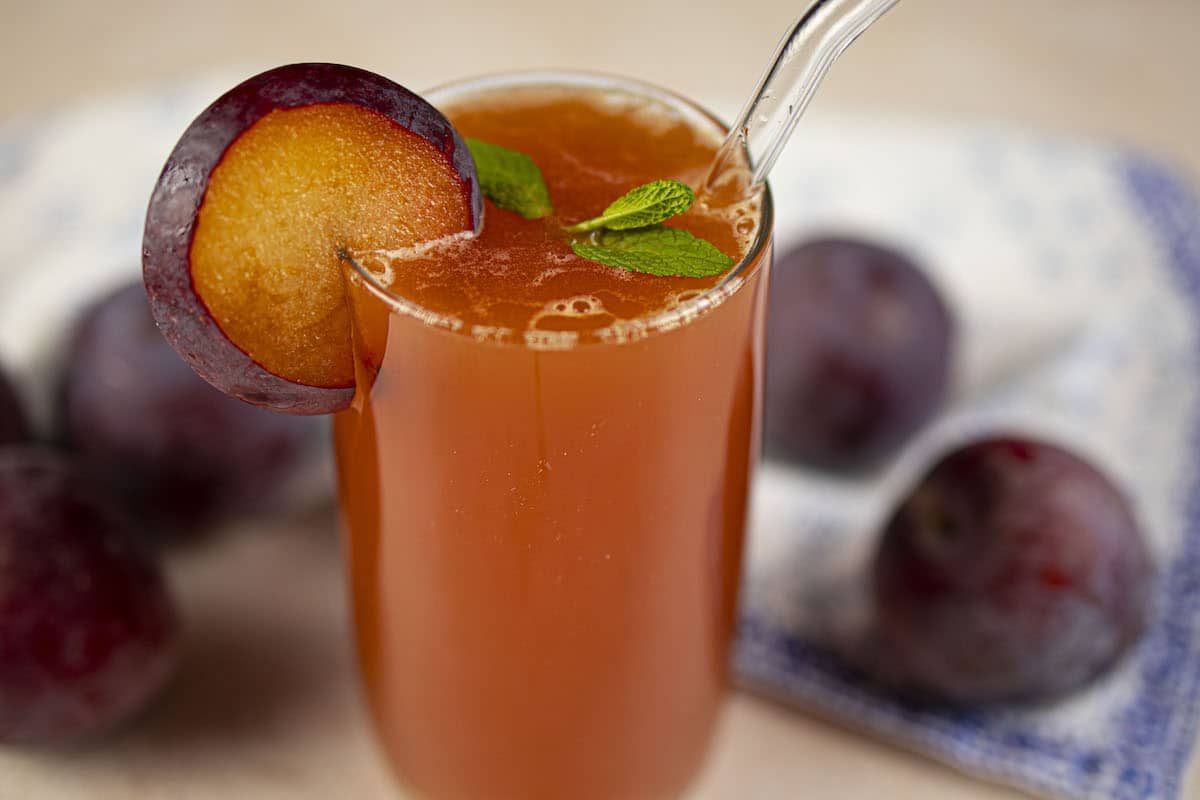
Plum juice is a delightful beverage packed with antioxidants and vitamins. The juice combines both a refreshing taste and exceptional nutritional benefits. It’s a perfect drink to quench your thirst, especially during hot summer days.
Here’s a simple guide on how to brew this refreshing drink.
Ingredients for Brewing Plum Juice
- Ripe plums
- Water
- Sugar (optional, for sweetness)
- Lemon juice (optional, for tanginess)
Equipment:
- Large pot
- Strainer
- Juicer (optional)
- Glass jars or bottles
Instructions:
1. Prepare the plums:
- Wash the plums thoroughly under running water to remove any dirt or debris.
- Cut the plums into halves and remove the pits.
2. Boil the plums:
- In a large pot, add the prepared plums and water.
- Bring the mixture to a boil over medium heat.
- Reduce heat and let the plums simmer for about 15-20 minutes, or until they become soft and the juice is released.
3. Strain the juice:
- Once the plums are soft, remove the pot from the heat and let it cool slightly.
- Strain the mixture through a fine-mesh strainer to remove the pulp and seeds.
4. Sweeten and flavour (optional):
- If you prefer a sweeter juice, add sugar to taste.
- For a tangy flavour, add a squeeze of lemon juice.
5. Bottle the juice:
- Pour the juice into clean, sterilized glass jars or bottles.
- Seal the containers tightly and store them in the refrigerator.
Tips for the Best Plum Juice
- Choose ripe plums: Ripe plums are sweeter and juicier, resulting in a more flavorful juice.
- Adjust sweetness and tartness: Taste the juice before bottling and adjust the sweetness and tartness to your preference.
- Store properly: Store the juice in the refrigerator to keep it fresh.
- Use a juicer: For a faster and more efficient process, use a juicer to extract the juice from the plums.
Can I freeze plum juice?
Yes, you can absolutely freeze plum juice to extend its shelf life and enjoy it long after the fresh fruit season has passed. Freezing plum juice is a practical and convenient way to savour its flavour year-round.
When freezing plum juice, be sure to use high-quality, freezer-safe containers to prevent leakage and freezer burn. Glass mason jars or BPA-free plastic containers work excellently for this purpose.
Remember to leave about 1 inch of headspace at the top of each container to allow for the natural expansion that occurs as the juice freezes. This extra space prevents the containers from cracking or bursting in the freezer.
For optimal quality and freshness, try to minimize the amount of air exposure in the containers before sealing them tightly. You can achieve this by using a ladle to carefully pour the juice, leaving as little headspace as possible.
Alternatively, you can use a funnel to fill the containers, further reducing air pockets.
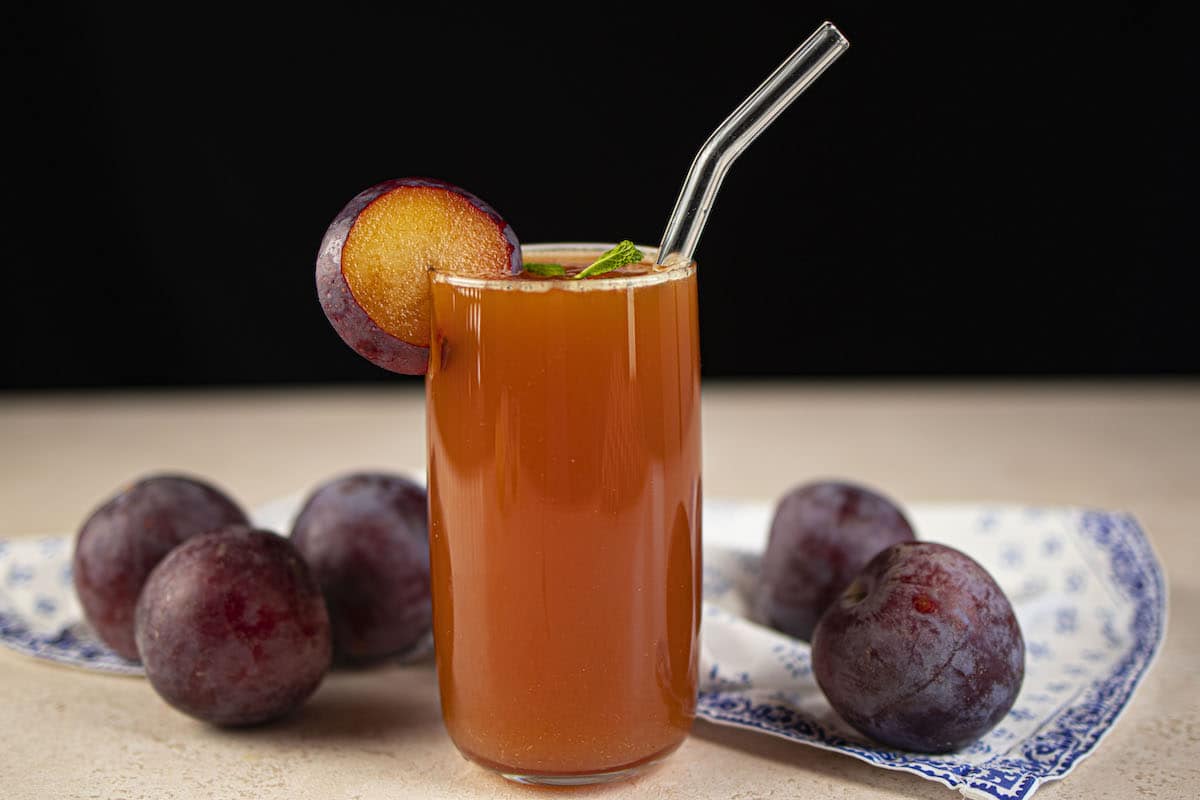
How long does homemade plum juice last in the refrigerator?
Homemade plum juice, when stored in airtight containers and refrigerated, can typically last for 3-4 days. However, the exact shelf life can vary depending on some factors.
These factors include the freshness of the plums, the cleanliness of the storage containers, and the temperature of the refrigerator. To maximize the shelf life of your homemade plum juice, it’s important to:
- Use fresh, ripe plums.
- Clean and sanitize the jars or bottles you’ll use to store the juice to prevent bacterial growth.
- Refrigerate promptly. Once the juice has cooled down, refrigerate it as soon as possible.
- Keep the refrigerator temperature consistent to maintain the quality of the juice.
By following these tips, you can enjoy your delicious homemade plum juice for a longer period.
Can I use dried plums to make juice?
Absolutely, dried plums, commonly known as prunes, can be repurposed to create a delightful and nutritious juice. While fresh plums are the ideal choice for juicing, using dried plums is a viable alternative, especially when the fresh fruit is out of season or unavailable.
However, there’s an important step to consider when using dried plums for juice – the rehydration process. Dried plums have a significantly lower moisture content compared to their fresh counterparts, so they require a bit of preparation before being juiced.
Begin by soaking the dried plums in water for at least 4-6 hours, or overnight, to allow them to regain their plumpness and soften.
This crucial step ensures the dried plums can be broken down effectively during the boiling process, extracting maximum flavour and nutrients into the resulting juice.
Once rehydrated, the dried plums can be treated the same as fresh plums in the juicing method, yielding a rich, concentrated elixir brimming with the sweet-tart taste of prunes.
With a bit of extra prep work, dried plums can be seamlessly incorporated into your homemade juice repertoire, providing a delicious and versatile option for year-round enjoyment.
What are the health benefits of plum juice?
Plum juice is a true elixir of health, packed with an impressive array of beneficial nutrients and compounds. At the heart of its wellness-boosting properties are the high levels of antioxidants.
This is particularly polyphenols, which help neutralize harmful free radicals and protect cells from oxidative stress.
Beyond the antioxidant powerhouse, plum juice is also a rich source of essential vitamins, including vitamins A, C, and K, which support immune function, skin health, and blood clotting, respectively.
Additionally, the juice contains minerals like potassium, phosphorus, and magnesium, all of which play crucial roles in maintaining cardiovascular health, regulating blood pressure, and facilitating proper digestion.
Regularly incorporating plum juice into your diet can yield tangible benefits for your overall well-being. The combination of antioxidants, vitamins, and minerals can help improve digestion.
This is done by promoting healthy gut function, boosting immunity to ward off common illnesses, and supporting cardiovascular health by lowering inflammation and cholesterol levels.
Truly, plum juice is a refreshing and restorative beverage that can be a valuable addition to any health-conscious lifestyle.
Can I use plum juice in cooking?
Yes, plum juice can be a versatile ingredient in your kitchen. Its unique sweet-tart flavour can elevate various dishes. You can use it to deglaze pans, create flavorful sauces for roasted meats, or add a fruity twist to marinades.
In baking, plum juice can be used to moisten cakes, add depth to frostings, or create unique glazes for pastries. Its natural sugars and acidity make it a great alternative to artificial flavourings and sweeteners.
You can enjoy the refreshing taste of homemade plum juice with those simple steps above. Experiment with different varieties of plums to discover your favourite flavour profile.
Did you learn the basic things you need to brew your homemade plum juice? Would you like to read more articles on drinks? Visit here.
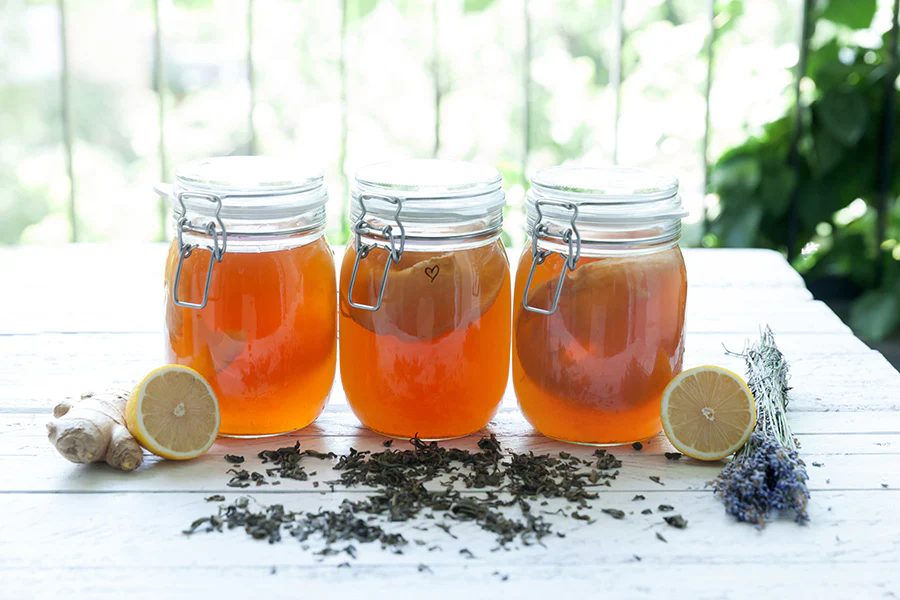
Kombucha tea, a fizzy fermented drink, has grown in popularity worldwide for its probiotic benefits and refreshing taste. While kombucha may not yet be widely popular in Nigeria, it is easy to make at home with a few ingredients.
Here’s a step-by-step guide to making kombucha tea in Nigeria, along with some frequently asked questions about this healthy drink.
What is Kombucha Tea?
Kombucha is a fermented tea made with a blend of tea, sugar, and a live culture known as SCOBY (Symbiotic Culture of Bacteria and Yeast). The SCOBY ferments the tea over some time, creating a unique beverage that is slightly sour, a bit sweet, and full of probiotics.
Kombucha contains beneficial bacteria, organic acids, and antioxidants, making it a popular choice for health enthusiasts.
Ingredients Needed to Make Kombucha Tea
To get started, gather these ingredients, which are often easy to find in Nigerian stores or markets.
- Water – Filtered or distilled is best, but boiled tap water also works.
- Sugar – White sugar is ideal as it’s easily fermented by the SCOBY.
- Tea – Black tea is traditional, but green tea or a blend of both can be used.
- SCOBY – You can purchase one online or from someone who makes kombucha.
- Starter Liquid – This is usually a bit of already-made kombucha or vinegar.
Steps to Making Kombucha Tea
Step 1: Make Sweet Tea
Begin by making sweet tea. This will be the base for your kombucha.
1. Boil the Water: Boil about 4 cups of water and let it cool slightly.
2. Add Sugar: Dissolve one cup of sugar in the hot water. Stir well to make sure it dissolves completely.
3. Add Tea Bags: Add 4-5 tea bags or 2 tablespoons of loose tea. Let it steep for 10-15 minutes.
4. Cool the Tea: After steeping, remove the tea bags and let the tea cool to room temperature.
Step 2: Combine the Ingredients
1. Pour the Tea into a Jar: Transfer the sweetened tea into a clean, large glass jar.
2. Add the SCOBY and Starter Liquid: Add the SCOBY and 1-2 cups of starter liquid (either previously brewed kombucha or distilled vinegar) to the jar. The starter liquid helps maintain the right pH for fermentation.
3. Cover the Jar: Use a clean cloth or paper towel to cover the jar and secure it with a rubber band. This keeps dust and insects out but allows air to flow.
Step 3: Fermentation Process
Place the jar in a warm, dark place to ferment. The ideal temperature for fermentation is between 24-30°C, so a shelf or cupboard in your kitchen should work well in most Nigerian homes.
1. Wait for Fermentation: Let the tea ferment for 7-10 days. Check after 5-7 days to see if it’s at the desired taste. The longer it ferments, the more acidic it will become.
2. Taste and Remove the SCOBY: After reaching the desired taste, remove the SCOBY and set it aside in a small jar with a bit of kombucha to keep it active for your next batch.
Step 4: Second Fermentation (Optional)
If you want a fizzy, flavoured kombucha, a second fermentation step is optional but recommended.
1. Add Flavorings: Pour the kombucha into individual bottles and add flavourings like ginger, fruit juice, or herbs. For example, pineapple, ginger, and hibiscus are popular in Nigeria.
2. Seal and Ferment Again: Seal the bottles tightly and let them sit at room temperature for 2-3 days to develop carbonation. Be sure to open the bottles carefully, as the pressure can build up.
Storing and Serving Kombucha Tea
Once fermented, store kombucha in the fridge to slow down further fermentation. Serve it cold and enjoy its refreshing taste.
Here are three popular questions people often ask on Google about kombucha.
Can I use different types of tea to make Kombucha?
Yes, you can use various tea types like green, oolong, or white tea. However, black tea is traditionally preferred because the SCOBY thrives on its richness.
Experimenting with tea blends can result in unique flavours, but avoid herbal teas without true tea leaves as they lack the necessary nutrients for fermentation.
How do I get a SCOBY in Nigeria?
Finding a SCOBY may seem challenging, but there are several options. You can purchase a SCOBY from online marketplaces or locate local kombucha makers willing to share one. Some health stores may also carry SCOBYs.
Alternatively, you can grow your own SCOBY by leaving store-bought kombucha in a warm place for a few days until it thickens.
What are the health benefits of Kombucha?
Kombucha offers several health benefits due to its probiotic content. It can aid digestion, support immune health, and provide antioxidants. Many believe kombucha can also boost energy levels thanks to its B vitamins and natural organic acids.
However, kombucha is not a cure-all, so it’s best to consume it as part of a balanced diet.
Tips for Success in Making Kombucha
- Maintain Cleanliness: To prevent contamination, ensure all your equipment is clean. Avoid using metal utensils, which can react with kombucha.
- Adjust Sugar and Tea Ratios: Experiment with sugar and tea quantities based on your taste preference. However, avoid reducing the sugar too much, as it’s essential for fermentation.
- Store in Glass Containers: Use glass jars or bottles when fermenting kombucha. Plastic containers may contain harmful chemicals that can leach into the kombucha.
- Monitor for Mold: If you notice any mould on the SCOBY, discard it immediately. Mold is a sign of contamination, and it’s best to start a new batch.
The Bottom Line
Making kombucha in Nigeria is easy and affordable. It’s an enjoyable way to try something new and potentially improve your gut health. With a few ingredients and some patience, you can brew your own kombucha right at home.
Making kombucha is a versatile process, so feel free to experiment with different flavours and fermentation times to create a brew that suits your taste. Whether you’re new to kombucha or a seasoned enthusiast, this guide will help you get started on making your own refreshing kombucha tea in Nigeria.
For more articles, visit here.
Latest


Nicki Minaj Features Davido On “The Pink Print” 10th Anniversary Edition
Nigerian superstar Davido has joined forces with Nicki Minaj for an exciting new track. The collaboration appears on the 10th-anniversary...


Falz Speaks About His Worst Date Experience
Nigerian rapper Falz recently shared a humorous yet awkward story from one of his early dating experiences. During an interview...


“Everybody Loves Jenifa” Can Beat ₦5 Billion – Funke Akindele
Funke Akindele aims to achieve a record-breaking ₦5 billion in ticket sales with her new film, Everybody Loves Jenifa, set...


Wizkid Releases His Highly Anticipated Album, “Morayo”
After months of anticipation, Wizkid has finally dropped his highly awaited eighth project and sixth studio album, Morayo. He named...


Lee Min-Ho Returns To The Big Screens In Netflix’s “When The Stars Gossip”
Lee Min-ho is set to make a triumphant return to the big screens with Netflix’s upcoming South Korean series When...


Wizkid’s “Dance” Reappears On Apple Music Nigeria Top 100
Wizkid’s ‘Kese (Dance)’ Reclaims Top Spot on Apple Music Nigeria Wizkid’s latest single, ‘Kese (Dance)‘ dramatically returned to the Apple...


Rema And Seun Kuti To Perform At 2025 Coachella
The 2025 Coachella Music Festival has revealed its spectacular lineup. Over 100 artists will perform at the iconic three-day event....


Denzel Washington Opens Up About 15-Year Battle With Alcohol
Hollywood icon Denzel Washington recently disclosed his past struggles with alcohol during an interview with Esquire. The two-time Academy Award...


Davido’s “Na Money” Wins Best Costume/Styling At Berlin Fashion Film Festival
Davido’s “Na Money” music video, featuring Angélique Kidjo and The Cavemen, has earned the prestigious Best Costume/Styling (Craft) award at...


“Gladiator II” Records ₦99.1 Million In Its Opening Weekend At The Nigerian Box Office
Ridley Scott’s Gladiator II has taken the Nigerian box office by storm, earning an impressive ₦99.1 million during its opening...
-Ad-




12 Daily Habits That Cause Mouth Odour Even After Brushing

Learn How To Cook Efo Riro Soup With This Easy Recipe

Do Bras Really Keep Breasts From Sagging? Check This Out!

See Cute Saint’s Collection At Lagos Fashion Week 2024

Meet Efunroye Tinubu, The Influential Slave Trader Who Controlled Lagos

Davido Debuts On Lagos Fashion Week Runway For Ugo Monye

3 Eggless Cake Recipes To Try At Home

If You’re Looking For Trouble, Let’s Go – Falz Replies Verydarkman

Veekee James Claps Back At Troll Who Insulted Her Looks

5 Most Affordable Places To Eat Pasta In Lagos
Trending
-

 DRINKS7 days ago
DRINKS7 days ago5 Health Benefits Of Drinking Warm Water Early In The Morning
-

 BUSINESS5 days ago
BUSINESS5 days ago6 Things To Consider Before Starting A Business In Nigeria
-

 TRAVEL6 days ago
TRAVEL6 days ago10 Fun Places You Can Visit In Abuja With Just 5k
-

 FOOD6 days ago
FOOD6 days ago6 Creative Ways To Make The Most Of Rice In Nigeria
-

 ARTS & CULTURE7 days ago
ARTS & CULTURE7 days agoWhy Ancient Africans Were Naked And Didn’t Care About “Decency”
-

 HEALTHY LIVING7 days ago
HEALTHY LIVING7 days ago5 Health Problems That Can Develop From Crying
-

 MOVIES4 days ago
MOVIES4 days ago“The Interrogation Of Lotanna” Bags 6 Nominations At The FilmJoint Awards 2025
-

 INTERNATIONAL2 days ago
INTERNATIONAL2 days ago“Gladiator II” Records ₦99.1 Million In Its Opening Weekend At The Nigerian Box Office


